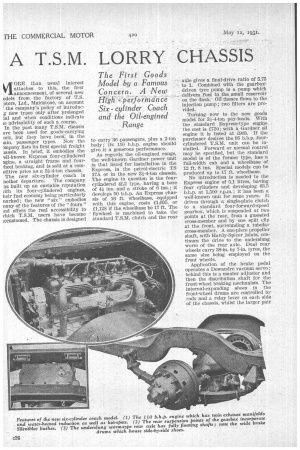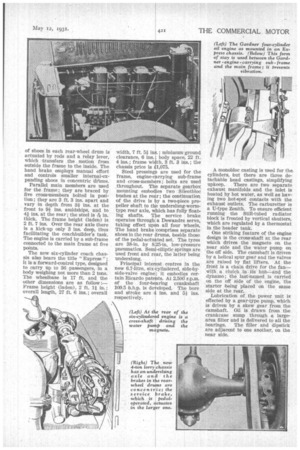T.S.M. LORRY CHASSIS
Page 88

Page 89

If you've noticed an error in this article please click here to report it so we can fix it.
The First Goods Model ky a Famous Concern. A New High performance Sixcylinder Coach and the Oil-engined Range
4 ORE than usual interest attaches to this, the first announcement, of several new odels from the ' factory of T.S. .otors, Ltd., Maidstone, on account : the company's policy of introducg new types only after prolonged ial and when conditions indicate ie advisability of such a course.
In the past many T.S.M. chassis aye been used for goods-carrying ork, but they have been in the lain, passenger types. Now the mapany lists its first special freight tassis. In brief, it embodies the 'ell-known Express four-cylindered agine, a straight frame and four!heel braking, and is sold at a Cometitive price as a 31-4-ton chassis. The new six-cylinder coach is nether departure. The company as built up an enviable reputation vith its four-cylindered engines, heir fuel economy being particularly narked ; the new " six " embodies nany of the features of the " fours " Lnd offers the real accessibility to vhich T.S.M. users have become iccustomed. The chassis is designed to carry 36 passengers, plus a 2-ton body ; its 110 b.h.p. engine should give it a generous performance.
As regards the oil-engined range, the well-known Gardner power unit is that listed for installation in the Express, in the petrol-electric TS 17A or in the new 31-4-ton chassis. The engine in question is the fourcylindered 4E2 type, having a bore of 4/ ins, and a stroke of 6 ins.; it develops 50 b.h.p. An Express chassis of 16 ft. wheelbase, ,equipped with this engine, costs £1,095, or £1,128 if the wheelbase be 17 ft. The flywheel is machined to take the standard T.S.M. clutch and the rear axle gives a final-drive ratio of 5.75 to 1. Combined with the gearboxdriven tyre pump is a pump which delivers fuel to the small reservoir on the dash: Oil thence flows to the injection pump; two filters are provided.
Turning now to the new goods model for 31-4-ton pay-loads. With the standard Express-type engine the cost is £720; with a Gardner oil engine it Is listed at £903. If the purchaser desires the 95 b.h.p. four, cylindered T.S.M. unit can be installed. Forward or normal control may be specified, but the standard model is of the former type, has a full-width cab and a wheelbase of 12 ft. 8 ins. Special models can be produced up to 17 ft. wheelbase.
No introduction is needed to the Express engine of 5.1 litres, having four cylinders and developing 63.5 b.h.p. at 1,500 r.p.m.; it has been a well-known unit for some years. It drives through a single-plate clutch to a standard four-forward-speed gearbox, which is suspended at two points at the rear, from a gusseted cross-member and by one split clip at the _front, surrounding a tubular .cross-member. A one-piece propeller shaft, with Hardy-Spicer joints, continues the drive to the underslung worm of the rear axle. Dual rear wheels carry 38-in. by 7-in, tyres, the same size being employed on the front wheels.
Application of the brake pedal operates a Dewandre vacuum servo; behind this is a master adjuster and then the distribution shaft for the front-wheel braking mechanism. The internal-expanding shoes in the front-wheel drums are controlled by rods and a relay lever on each side of the chassis, whilst the larger pair
of shoes in each rear-wheel drum is actuated by rods and a relay lever, which transfers the motion from outside the frame to the inside. The hand brake employs manual effort and controls smaller internal-expanding shoes in concentric -dibms.
Parallel main members are used for the frame; they are braced by five cross-members bolted in position ; they are 3 ft. 3 ins, apart and vary in depth from 31 ins, at the front to 01 ins, amidships, and to 41 ins, at the rear; the steel is 156. in. thick. The frame height (laden) is 2 ft. 7 ins. Over the rear axle there Is a kick-up only 3 ins, deep, thus facilitating the coachbuilder's task. The engine is carried by a sub-frame connected to the main frame at five points.
The new six-cylinder coach chassis also bears the title " Express " ; it is a forward-control type, designed to carry up to 36 passengers, in a body weighing not more than 2 tons.
The wheelbase is 17 ft. and the•other dimensions are as follow :—
Frame height (laden), 2 ft. 11 in.; overall length, 27 ft. 6 ins.; overall width, 7 ft. 5i. •, minimum ground clearance, 6 ins, body space, 22 ft. 4 ins.; frame Width, 3 ft. 3 ins.; the chassis price is 0,075. Steel pressing S are used for the frame, engine-carrying sub-frame and cross-members; bolts are used throughout. The separate gearbox mounting embodies two Silentbloc bushes at the rear; the continuation of the drive is by a two-piece propeller shaft to the underslung-wormtype rear axle, which has fully floating shafts. Tae service brake operates througha Dewandre servo, taking effect up n all four wheels. The hand brake comprises separate shoes in the rear drums, beside those of the pedal-actuated set. The tyres are 38-in. by 8.25-in, low-pressure pneumatics. Semi-elliptic springs are used front and rear, the latter being underslung.
Principal intetlest centres in the new 6.7-litre, six-cylbadered, side-&yside-valve engine; it embodies certain Ricardo patents. At 2,500 r.p.m. of the four-bearing crankshaft 109.5 b.h.p. is deVeloped. The bore and stroke are 4 ins. and 51 ins. respectively. A monobloc casting is used for the cylinders, but there are three detachable head castings, simplifying upkeep. There are two separate exhaust manifolds and the inlet is heated by hot water, as well as having two hot-spot contacts with the exhaust outlets. The carburetter is a U-type Zenith. To ensure efficient running the Still-tithed radiator block is fronted by vertical shutters, which are regulated by a thermostat in the header tank.
One striking feature of the engine design is the cross-shaft at the rear which drives the magneto on the near side and the water pump on the off side. The camshaft is"driven by a helical spur gear and the valves are raised by flat lifters. At the _front is a chain drive for the fan— WO a clutch in' it's' htib=and the dynamo; the last-named is carried on the off Side of the engine, the starter being plaCed on the same side at the rear.
Lubrication of the power unit is effected by a gear-type pump, which is driven by a skew gear from the camshaft. Oil is drawn from the crankcase sump through a largearea filter and is delivered to all the bearings. The filler and dipstick are adjacent to one another, on the near side.




































































































































































































